 Application settings and overview
Application settings and overview

When running the application for the first time, you need to go to the settings first to configure it.
Overview
General shortcuts and behaviour
In all the application, a few shortcuts are always the same, in addition to your system’s usual shortcuts for copy, paste, undo etc.
[Middle Click]: scroll/pan in lists, tables, timeline…[Ctrl] + [Middle Click]or[Mouse Wheel]: zoom in or out in views which can be zoomed.[Shift] + [A]: add/create something.[Del]or[Shift] + [X]: remove/delete selection.
All side panels (docks) can be moved around and docked to the sides or undocked by clicking on their titles.
Menu bars can also be moved to all sides of the application.
Title bar

The title bar show the main buttons to switch the panels on the left, and the visibility buttons on the right. Click and drag an empty space of the title bar to move the whole window.

In the middle of the title bar is the selector where you can select the project you’re currently working on.
Hide. The application will not close but sit in the system tray.
Which panels and buttons are available depends on the role of the current user, and there may be fewer buttons than on the picture above.
Administration panel (Administrators only).
Project settings panel (Project administrators and Administrators only).
Pipeline editor panel (Project administrators and Administrators only).
Assets table panel.
Shots table panel.
Schedule panel.
Statistics panel.
Status bar

The status bar at the bottom of the window displays temporary feedback, useful messages and help on its left section. On the right section, there are a few secondary buttons.
The reload button updates all data from the server. You should not need to click this button too often as the data is automatically and regularly pulled from the server.
The console button shows the console panel (see the next section) where Ramses logs useful information for debugging or for developpers. Errors and warnings are also logged there.
|
A warning or an error button may be shown next, when there are some issues. Click on the button to show the latest logs and learn what’s wrong; a clear button is available on the popup to remove the warning.
- The online/offline button can be used to switch between online and offline mode. Going online may need to input your password again.
- The user button (which shows your user name, or Guest if you’re not logged in yet) gives access to a few user options (see below).
The settings button leads you to the settings of the application.
The help button shows a small menu with useful shortcuts.
Console

The console panel is where Ramses logs useful information for debugging or for developpers. Errors and warnings are also logged there, respectively in red and yellow.
As many other Ramses panel, the console is a docked panel which can be undocked or docked both on the right and left side of Ramses by just clicking its title and moving it.
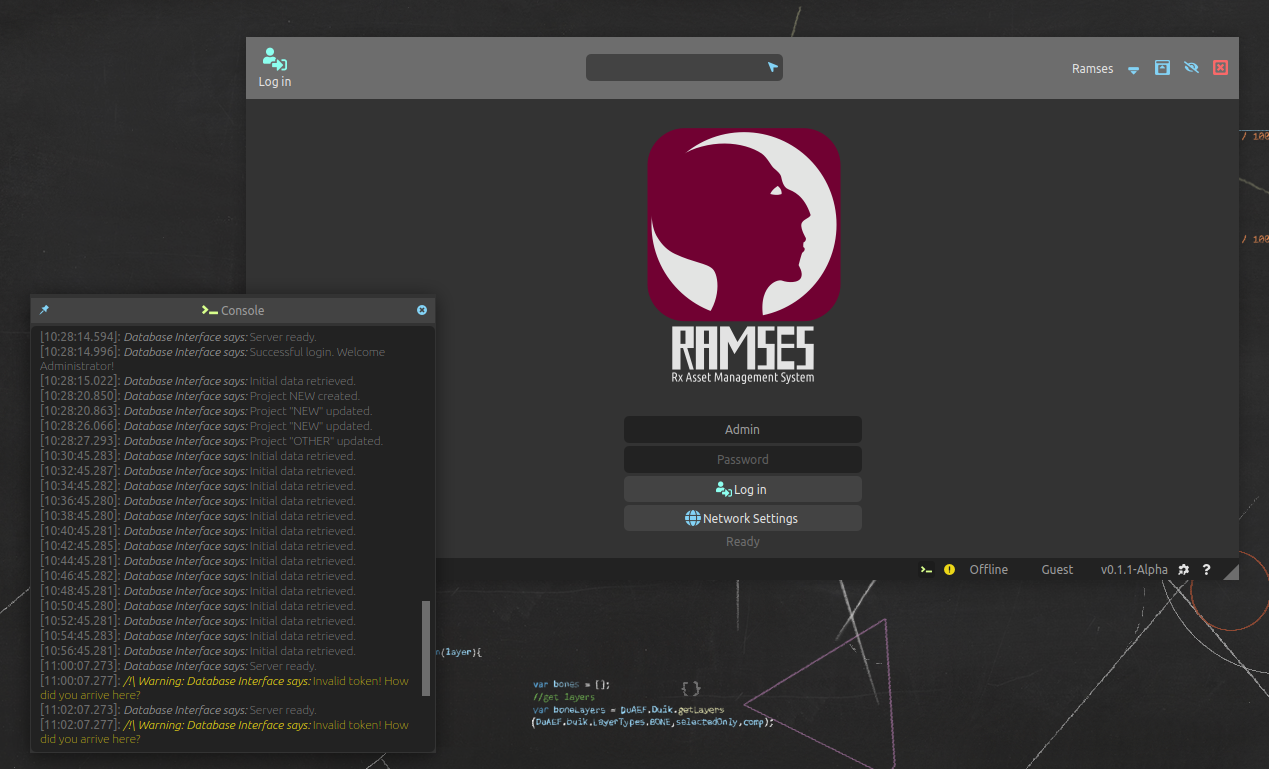
User Profile
Use the user menu at the bottom right of the window (the button with your ID) to access your profile settings.

Except for the password, there’s no need to validate any change; changes are saved instantly.
- Name is your display name and can be changed any time (although it’s not really advisable).
- ID is your unique identifier which is used in the files and folders (see Ramses Tree). It can’t be changed once your user folder has been created. Read the Ramses naming conventions to learn how IDs and names have to be formatted.
- Comment can be any text associated to your user. It is public.
- The Current role can never be changed by the user itself, and has to be changed by an administrator.
- To update your password, input your Current password and repeat your New password twice. Don’t forget to click the Change password button to validate!
- You can change the folder where your personnal files are stored.
- Leave the field empty to set back the default folder.
- The blue
button opens a folder selector to change the folder location.
- The green
button opens the folder in your file explorer.
Lists

There are a lot of lists in Ramses…
In all lists, you can grab the bottom margin of any row to reveal more details. Clicking on a item opens the corresponding properties in a side panel. If you need to select several items, you can click and hold while dragging the mouse to select contiguous items, or you can hold [Ctrl] while clicking items to select individual items.
The search bar uses both IDs and names to find items.
In most of the lists, [Del] and [Shift] + [X] can be used to remove items. [Middle Click] can be used to scroll the list, as the [Mouse Wheel] does too.
Comments

In many places, you can add Comments in Ramses. These comments can be simple texts, but they can also be formatted using the Markdown syntax.
Start by writing some text, and validate your input with [Enter] from the numpad. Ramses will interpret the text to display a nice rich text.
You can get back to the source to edit the text in more details using the [F2] key.
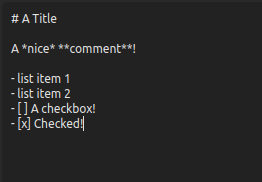
Use the [Right Click] context menu for other options.
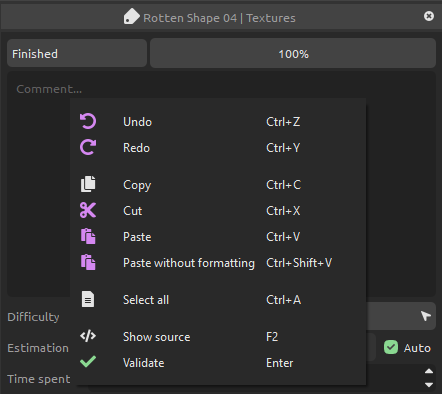
 Settings
Settings
To open the settings panel, click on the settings button at the bottom right corner of the window.
Note
These settings are local settings, and will not be shared with other workstations. Each workstation, (actually, each session on the system) has its own settings.
The purple button will restore all default settings.
Use the blue close button to close the settings. They are automatically saved.
 Appearance
Appearance
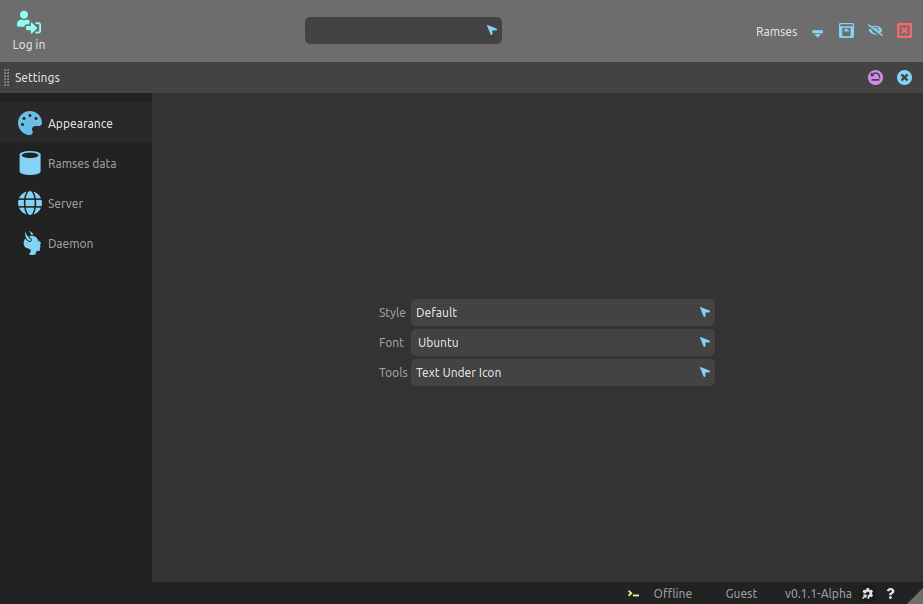
The first tab shows the appearance settings; you can change these as you wish.
 Ramses Data
Ramses Data
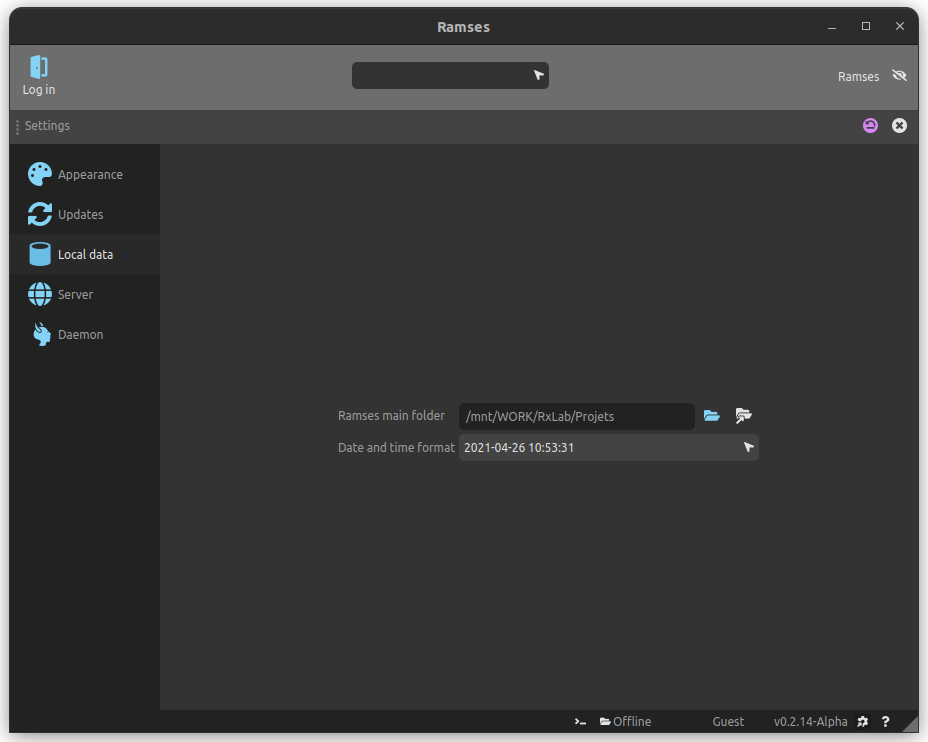
The second tab defines how Ramses will store the data on the filesystem, and has a few display option for the data.
- Ramses main folder defines the location of the main Ramses root folder, the one which will contain the
Config,ProjectsandUserssubfolders, as defined by the Ramses Tree.
By default, this folder is located in your user folder.
The blue button opens a folder selector to change the folder location.
The green button opens the folder in your file explorer.
Note
Project folders and user folders can be individually changed later to be outside of this main Ramses root folder, for example if you need to locate specific projects in other arbitrary specific folders. But Ramses still needs this main folder to be defined, at least to store some configuration files.
-
Date format defines how dates will be displayed in the user interface. It does not change anything about how the data is actually stored in the database and files.
-
Time format defines how times will be displayed in the user interface. It does not change anything about how the data is actually stored in the database and files.
 Server
Server
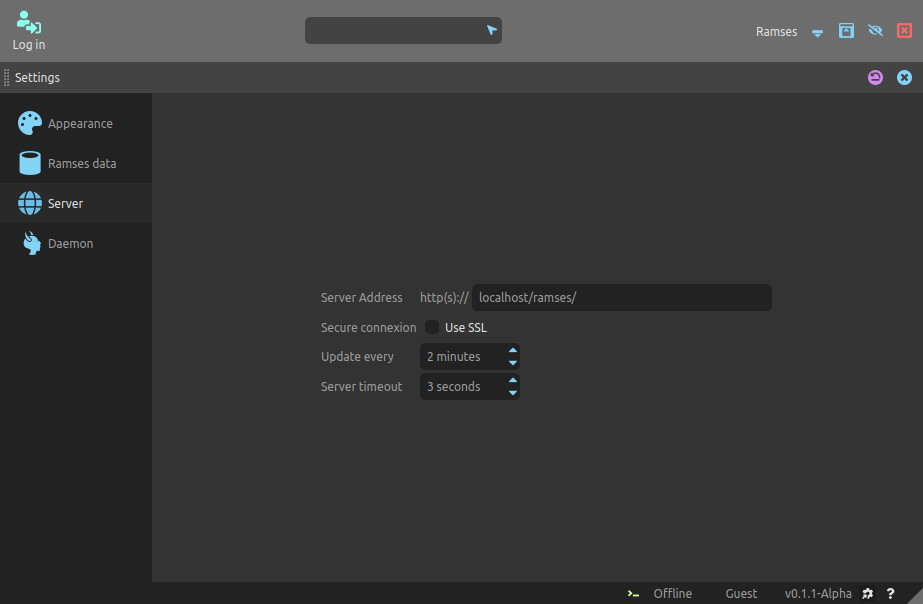
The third tab configures how the application will connect to the server.
-
Server address must be the complete URL to the server.
-
Secure connexion must be checked in case you want to encrypt the data sent to and recieved from the server. Your server must be compatible with SSL and have a valid certificate.
-
Update every X minutes defines how often the application will automatically update all its data from the server. In order to keep the application very lightweight and the server very light and easy to install on all kind of computers, the local data is not updated in realtime (there’s no pushing from the server), but the application will regularly pull changes from the server. This value does not need to be too low, as Ramses does not really need to be perfectly up-to-date every second. The default value is 2 minutes.
-
Server timeout defines how long the application will wait for the server response when getting or posting data. If this timeout expires, the server will be considered not working correctly and the application will switch to offline mode. You may raise a bit this value if your server or your connexion are particularly slow. The default value is 3 seconds.
 Daemon
Daemon
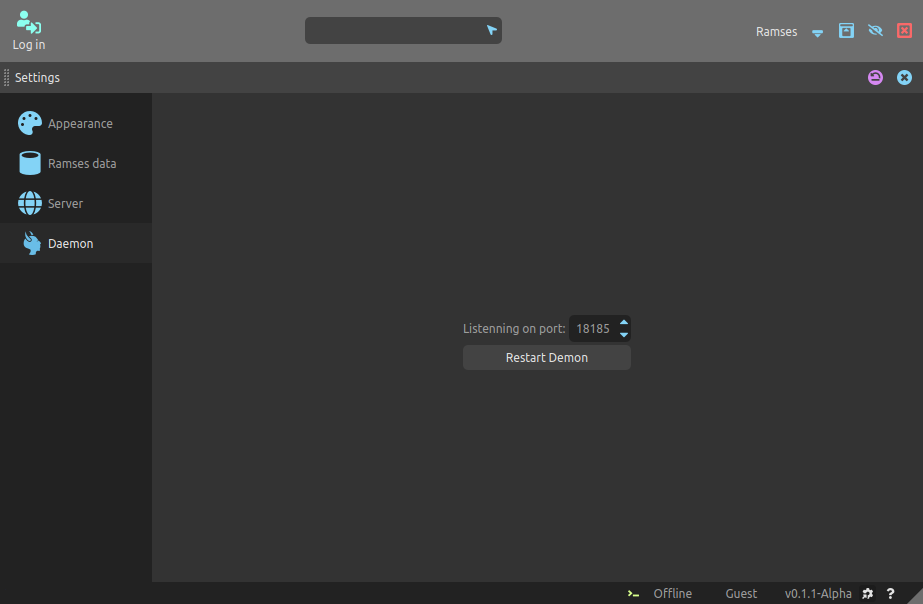
The Daemon is a background service, a small local server, which is started with the application and is in charge of communications with the Ramses Add-ons.
-
Listenning on port defines the local port used by the Daemon to receive connections and requests from the Ramses Add-ons and other services. You may change this value if it conflicts with other applications; in this case, you’ll have to change it in the settings of all the Ramses Add-ons too. The default value is 181851.
-
Click the Restart Daemon button when changing the listenning port to apply the change.